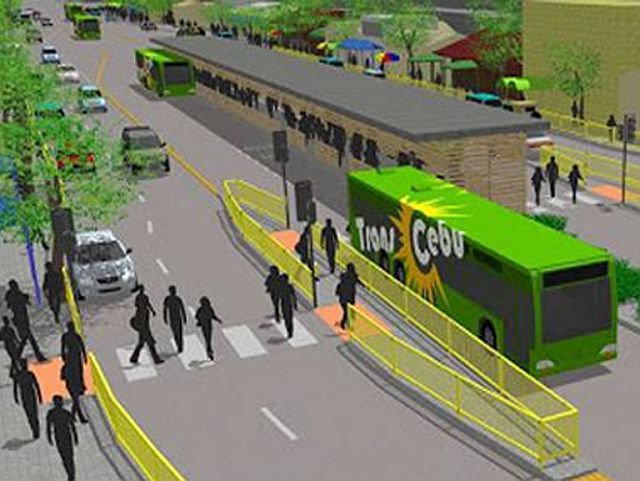
BRT Cebu image
Source DOTC
BRT PROJECT
Only a new mayor can stop the Cebu Bus Rapid Transit (BRT) project now.
In fact, Cebu City Mayor Tomas Osmeña is challenging Presidential Assistant for the Visayas Michael Dino, who is one of the biggest oppositors of the BRT project, to run against him in order to stop the project.
“I will teach Mr. Dino how to stop the BRT: have a recall of the mayor and run against me. If he wins, he can stop the BRT. I will agree to a recall. That’s the best way. I am teaching him,” he said during his regular news conference yesterday.
His comment came a day after the National Economic Development Authority (Neda) Board, chaired by President Rodrigo Duterte, approved on Tuesday afternoon the additional P5.69-billion budget for the project.
From a P10.6-billion budget initially approved, the BRT project now costs P16.3 billion.
In a Facebook post, the mayor also posted newspaper headlines about the approval of the additional budget.
“Have you ever seen a dinosaur cry? (smiley :D),” read the caption of his post. Although he did not name names, he was clearly alluding to Dino in his post.
Final Say
Dino, however, said the approval of the additional budget for the BRT is not an assurance that its implementation would push through.
“That’s just the budget being prepared, but the final approval for the implementation still lies of the Department of Transportation (DOTr),” he said.
“DOTr is the key. Neda will only approve the budget but only the transportation department has power to give the go-signal,” he added.
Dino said he is confident that the DOTr will see that the BRT project will fail in its goal to solve the traffic situation in Cebu City.
“BRT will do Cebu City more harm than good,” Dino said during a press conference at his office.
“Let us not forget the DOTr is still reviewing the project and they will realize that the BRT will only fail,” he added.
Dino said that he has already relayed his reservations about the BRT project to President Rodrigo Duterte.
“He said that he is for what is best for Cebu and I believe that LRT subway is still the best mass transport solution for Cebu,” Dino said.
According to Dino, the feasibility study for the LRT subway conducted by a private organization is ready to be presented any time soon.
Oppositors
Osmeña admitted that until the implementation of the BRT project is completed, there will still be people who would go against the project.
During it’s regular session last Tuesday, the Cebu City Council passed a resolution authored by Councilor James Anthony Cuenco, asking the BRT Project Implementation Unit (PIU) for a copy of the feasibility study of the BRT project for their perusal and for possible review.
“It’s not over until it’s over. They will not stop. They will try any other means to try to stop this project. That’s the nature of the other side. They cannot get anything for themselves. Now, they’re demanding a copy of the feasibility study. I personally don’t have it. It’s probably several thousand pages,” Osmeña said.
He added the arguments of the project’s detractors are “getting to be unreasonable.”
Cebu City Councilor Joel Garganera, who used to head the City Council’s committee on transportation, said that even with the budget approval, they will continue to raise concerns on the project.
For one, he said, the BRT will not have dedicated lanes in the portion from Ayala to Talamban. Mixing with regular traffic in this area, he said, will beat the purpose of the BRT in being “rapid” and well-timed.
Councilor Philip Zafra, who is also the president of the Association of Barangay Councils (ABC), said that while he is not against the project, there are some concerns that need to be looked into.
“The concerns of the barangays is that we want that a road widening should first be implemented for the whole stretch. It should be part of the implementation of the BRT. If there is no road widening, for us, it will really be a failure,” Zafra said.
BRT route
The 21.5-kilometer BRT route starts from Barangay Bulacao in the south district until Barangay Talamban in the north.
Only N. Bacalso Ave., Osmeña Blvd., and Escario St. will have dedicated lanes for the BRT buses. From Ayala to Talamban, passing through the Banilad-Talamban road, the buses will just mix with the regular traffic flow.
BRT PIU head Rafael Yap explained that the increase in the budget of the BRT project is for its road-right-of-way acquisition component.
It is also because of the passage of Republic Act 10752 or the Right of Way Act which requires government implementing agencies to offer the market value of properties to be acquired for government infrastructure projects.
With the approval of the budget, Yap said they will continue sending notices of taking with final offer to owners of properties along the BRT route that will be affected by the project.
These properties to be acquired will only be for certain areas of the BRT route where the bus stations and terminals will be constructed, and not for the entire stretch of the route.
Expect
Cebu City north district Rep. Raul Del Mar said he welcomed the Neda Board’s approval and said he was expecting it.
“That’s great. I expected Neda’s Board approval considering that it already had the prior approval of the Investment Coordinating Committee (ICC) where I presented the reasons for its approval upon the request of Mayor Tommy Osmeña who was in Tokyo,” he said.
Last August, the Neda ICC Cabinet Committee also approved the additional budget for the project. It was Del Mar who represented the city in the meeting and pushed for the approval of the budget increase.